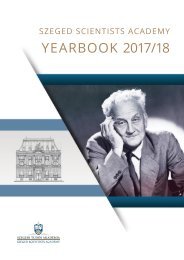You also want an ePaper? Increase the reach of your titles
YUMPU automatically turns print PDFs into web optimized ePapers that Google loves.
SZENT-GYÖRGYI JUNIOR MENTORS<br />
ANIKÓ KELLER-PINTÉR<br />
Faculty of Medicine,<br />
Department of Biochemistry,<br />
University of Szeged<br />
Address: Dom tér 9, H-6720 Szeged, Hungary<br />
RESEARCH AREA<br />
Skeletal muscle is constantly renewed in response to injury,<br />
exercise, or muscle diseases. During the regeneration<br />
process, the quiescent satellite stem cells are activated<br />
and form myoblasts that will subsequently migrate,<br />
differentiate, and then fuse to form muscle fibers. The<br />
analysis of signalling events of muscle regeneration and<br />
differentiation has an important role in developmental<br />
biology; and it helps to reveal the pathomechanisms and<br />
therapeutic possibilities of muscle diseases. Furthermore,<br />
it can contribute to enhance the muscle regeneration<br />
following sport injuries.<br />
Skeletal muscle is a highly dynamic tissue; it can change in<br />
size in response to physiological effects, or due to diseases<br />
(e.g. chronic cardiac disease, chronic kidney diseases, or<br />
cancer). Our other research projects focus on the analysis of<br />
the molecular mechanisms influencing muscle adaptation,<br />
regulation of muscle size and metabolism.<br />
About 90% of insulin-stimulated glucose uptake occurs in<br />
skeletal muscle and mediated by GLUT4 glucose transporter.<br />
The translocation of GLUT4 from the cytosol to the plasma<br />
membrane is deficient in type-2 diabetes. Our further<br />
aim is to study the signalling mechanisms regulating the<br />
translocation of GLUT4.<br />
TECHNIQUES AVAILABLE IN THE LAB<br />
SELECTED PUBLICATIONS<br />
Szentesi, P., Csernoch, L., Dux, L., Keller-Pinter, A. (20<strong>19</strong>)<br />
Changes in redox signaling in skeletal muscle during aging.<br />
Oxid Med Cell Longev. 20<strong>19</strong>:4617801.<br />
Keller-Pinter, A., Szabo, K., Kocsis, T., Deak, F., Ocsovszki,<br />
I., Zvara, A., Puskas, L., Szilak, L., Dux, L. (<strong>2018</strong>) Syndecan-4<br />
influences mammalian myoblast proliferation by<br />
modulating myostatin signalling and G1/S transition. FEBS<br />
Lett. 592:3139-3151<br />
Keller-Pinter, A., Ughy, B., Domoki, M., Pettko-Szandtner,<br />
A., Letoha, T., Tovari, J., Timar, J., Szilak, L. (2017) The<br />
phosphomimetic mutation of syndecan-4 binds and<br />
inhibits Tiam1 modulating Rac1 activity in PDZ interactiondependent<br />
manner. PLoS One. 12:e0187094.<br />
Kocsis, T., Trencsenyi, G., Szabo, K., Baán, J.A., Müller, G.,<br />
Mendler, L., Garai, I., Reinauer, H., Deak, F., Dux, L., Keller-<br />
Pintér, A. (2016) Myostatin propeptide mutation of the<br />
hypermuscular Compact mice decreases the formation of<br />
myostatin and improves insulin sensitivity. Am J Physiol<br />
Endocrinol Metab. 312: E150-E160.<br />
Keller-Pinter, A., Bottka, S., Timar, J., Kulka, J., Katona, R.,<br />
Dux, L., Deak, F., Szilak, L. (2010) Syndecan-4 promotes<br />
cytokinesis in a phosphorylation-dependent manner. Cell.<br />
Mol. Life Sci. 67: 1881–94.<br />
Mammalian tissue culture techniques, in vivo animal models,<br />
immunohistochemistry, immunocytochemistry, fluorescent<br />
microscopy, image analysis, analysis of cell migration, flow<br />
cytometry, cell cycle analysis, cell proliferation assays,<br />
spectrophotometry (measurement of enzyme activities,<br />
metabolites), PCR, co-immunoprecipitation, GTP-ase<br />
activity assays, Western blot, glucose tolerance test, insulin<br />
tolerance test.<br />
82












